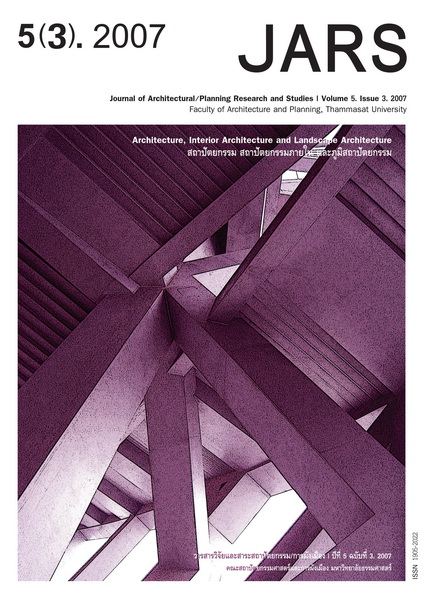Design Guidelines for Sustainable Urban Park in Brownfield Sites of Bangkok Metropolitan Area
Main Article Content
Abstract
Urban park is used for citizens’ recreation area in neighborhood, community, city, and region
scale. From the idea of sustainable development, the goal is to sustain human communities by development
that does not destroy the fundamentally environmental life support system. When apply this idea to urban
park as sustainable park, the focus is on solutions to ecological problems and the improvement of quality
of life in the area that the park is located. Bangkok the metropolitan area extended by the influence
from industry and economic growth, is encountering with ecological problems such as air pollution, flooding,
public hazard, and lacking of open space to reduce people’s stress from over population condition. In
addition, Bangkok, like many cities, contains large derelict sites brownfields including industrial yards,
under-used port fields, old gas station, former military base, obsolete transportation system, and lands
where are idle for decades that have potential for sustainable park development. The objectives of this
research are 1) to study the idea of sustainable park that relates to physical elements, activities, and
management of the park 2) to study design guidelines for sustainable urban park in brownfield sites to
apply in Bangkok by using case studies and park’s user attitude questionnaires. The result of the
research reveals that the physical elements of the park relate to the context. They emphasize internal
resource self-sufficiency in regard to material resources including the use of native plants, restoration of
steams or wetland, recycling fertilizers, and using permeable surface materials. The physical elements also
express the new mode of aesthetics. There are activities of sustainable park to promote natural value
education. The management focuses on communities stewardship and low-cost maintenance. When
apply the sustainable park idea to brownfield sites of Bangkok metropolitan area, the new park should
have zoning area for activities to encourage users have positive attitude about nature and general activities
relating to context. Three approaches of design are taken to artistically, ecologically dramatize the spirit
of the site using these elements: preservation, modification, and creation of new form.
Downloads
Article Details

This work is licensed under a Creative Commons Attribution-NonCommercial-NoDerivatives 4.0 International License.
All material is licensed under the terms of the Creative Commons Attribution 4.0 International (CC-BY-NC-ND 4.0) License, unless otherwise stated. As such, authors are free to share, copy, and redistribute the material in any medium or format. The authors must give appropriate credit, provide a link to the license, and indicate if changes were made. The authors may do so in any reasonable manner, but not in any way that suggests the licensor endorses you or your use. The authors may not use the material for commercial purposes. If the authors remix, transform, or build upon the material, they may not distribute the modified material, unless permission is obtained from JARS. Final, accepted versions of the paper may be posted on third party repositories, provided appropriate acknowledgement to the original source is clearly noted.
References
Schneekloth, L. H. (2005). Time-saver standards for urban design. New York: McGraw-Hill.
Moughin, C., & Shirley, P. (2005). Urban design: Green dimension. Oxford: Architectural Press.
Cranz, G., & Boland M. (2002). Defining the sustainable park: A fifth model for urban parks. Landscape Journal, 19, 102-120.
San Francisco Bay Area Hiker. (2006). Crissy Field. Retrieved September 8, 2006 from http:// www. bahiker.com/sfhikes/crissy.html
Thompson, C. W. (2002). Historic American and contemporary needs. Landscape Journal, 17, 1-25.
Helmke, P. (2002). Brownfield revitalization. Retrieved January 9, 2007, from http:// www.epa.gov/brownfields/policy/initiatives_sb.html
ประยงค์ โพธิ์ศรีประเสริฐ และณัฐวุฒิ อัศวโกวิทวงศ์. (2549). เครือข่ายพัฒนาสิ่งแวดล้อมชุมชน: กลยุทธ์และกระบวนการเพื่อการพัฒนาชุมชนแออัดอย่างยั่งยืน. วารสารวิจัยและสาระสถาปัตยกรรม/การผังเมือง, 4, 51-70.
Environment Protection Agency. (2002). Atlantic steel redevelopment project. Retrieved February 12, 2007, from http:// www.epa.gov/Region4/opm-nepa/atlanticsteel.html
มหาวิทยาลัยเกษตรศาสตร์. (2546). รายงานฉบับสมบูรณ์ แผนแม่บทพื้นที่สีเขียว กรุงเทพมหานคร (รายงานฉบับสมบูรณ์). กรุงเทพฯ: โรงพิมพ์มหาวิทยาลัยเกษตรศาสตร์.
สำนักสวนสาธารณะ. (2003). สวนกีฬารามอินทรา. สืบค้นเมื่อ 15 ธันวาคม 2549, จาก http://203.155.220.217/office/ppdd/publicpark/thai/mainpark/T-ramindra.html
American Society of Landscape Architects. (2001). Zhongshan Shipyard Park. Retrieved December 22, 2006, from http:// www.asla.org/meeting/awards/awards02/Zhongshan.html
Estudos e Projectos de Arquitectura Paisagista. (1998). Pargue de tejo e trancao. Retrieved February 6, 2007, from http:// www.proap.pt/site/L_eng/projectos/03000_parque_tejo.html
Tate, A. (2000). Great city park. New York: Harry N. Adrams Publishing.
Andropogon Associates. (2002). Lewes canalfront park project, master plan and phase imprementation. Retrieved September 22, 2006, from http:// www.andropogon.com/ft/lewes


